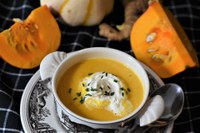Prairie Fare: The Aroma of Pumpkin Spice Fills the Autumn Air
(Click an image below to view a high-resolution image that can be downloaded)
By Julie Garden-Robinson, Food and Nutrition Specialist
NDSU Extension
I heard our dogs yipping at 4:30 a.m. They were persistent.
I went downstairs to see what they wanted. They did not want to leave the warm house to investigate our backyard.
They sat near the table looking up at a box of chewy, teeth-cleaning treats. They barked until I got the message.
They usually get a treat at 6 a.m. when I make coffee.
I have created a monster. Actually I have created three cute little monsters. They wanted their chewy treats early.
I was awake by now, as was our household. Fortunately, I had three treats left.
Because I am well trained by our dogs, treats were added to my grocery list.
A box of pumpkin spice dog treats caught my eye. That didn’t even sound good. I bought their usual flavor.
While grocery shopping, I noticed pumpkin spice-flavored items, including yogurt, coffee creamer, tea, snack bars, cookies, cream cheese, cereal and oatmeal. I noted the small container of pumpkin spice was almost $6.
When I needed a second cup of coffee later that morning, pumpkin spice lattes were an option.
What is “pumpkin spice,” anyway? This blend of spices goes into pumpkin pie, pumpkin bars and, apparently, almost any kind of food in the fall.
If you have spices on your shelf, you can make your own pumpkin spice with these proportions: 1 part cinnamon (1 teaspoon) to 1/4 part nutmeg (1/4 teaspoon) to 1/4 part ground ginger (1/4 teaspoon) to 1/8 part ground cloves (1/8 teaspoon). Some recipes also incorporate allspice.
You can scale up the recipe and fill your own spice containers with this autumn mix.
Instead of pumpkin spice-flavored items, consider eating more pumpkin. Pumpkins are packed with nutrients, especially beta-carotene and fiber. Our bodies use beta carotene to produce vitamin A.
In fact, 1/2 cup of pumpkin provides more than a full day’s supply of vitamin A, along with lutein and zeaxanthin, which are pigments that promote eye health. Pumpkin is rich in potassium, which helps our muscles contract and nerves fire.
One-half cup of mashed pumpkin has just 24 calories.
Try pumpkin soup or pumpkin hummus. Add some pumpkin puree to pasta sauce or chili. Sweeten pumpkin with some honey. Make a pumpkin parfait by layering yogurt with honey-sweetened pumpkin. You also can use pumpkin to substitute for part of the fat in baked goods such as brownies.
Many people have jack-o’-lanterns smiling from doorsteps, but the large pumpkins usually are not the ones to select for cooking. “Sugar pumpkins” are smaller, rounder pumpkins well suited for culinary use.
Fresh pumpkin can be baked/cooked and used in the same way you would use canned pumpkin. Rinse, cut in half and scoop out the seeds and stringy parts. Spray a baking sheet with sides with nonstick cooking spray and lay the pumpkin flat side down on the baking sheet. Bake for about an hour, and scoop out and mash or puree the flesh in a food processor.
Freshly cooked pumpkin often will have a lighter color and a texture more like sweet potatoes.
Canned pumpkin offers one-step convenience; simply open the can and use. Canned pumpkin usually has a stronger pumpkin flavor and results in a pie with a firmer, smoother texture. Pumpkin is pulverized before commercial canning to give it a uniformly smooth texture.
We do not have an approved (safe) method for canning mashed pumpkin at home. Pumpkin chunks can be canned. See http://nchfp.uga.edu/tips/fall/pumpkins.html for information about preserving pumpkin.
If you have extra cooked or canned pumpkin, you can freeze it in recipe-sized amounts. Try freezing extra pumpkin in an ice cube tray and add a cube or two to chili, cooked oatmeal or smoothies to get the benefit of pumpkin.
Hungry for pumpkin recipes? Visit https://www.ag.ndsu.edu/food and click on “Recipes” then type “pumpkin muffins” or “pumpkin soup” or “pumpkin bread pudding” (my personal favorite) for a variety of tasty recipes.
Here’s a savory pumpkin soup that incorporates some of fall’s bounty.
Creamy and Savory Pumpkin Soup
2 c. finely chopped onions
2 green onions, sliced thinly, tops included
1/2 c. finely chopped celery
1 green chili pepper, chopped
1/2 c. canola oil (or your favorite cooking oil)
3 (14.5-ounce) cans chicken broth, reduced sodium, or 6 cups homemade chicken stock
1 (16-ounce) can solid pack pumpkin
1 bay leaf
1 1/2 tsp. ground cumin
1 c. undiluted evaporated skim milk
Salt and pepper to taste
Parmesan cheese, sour cream and/or fresh chopped parsley
Note: Canned chicken broth and canned pumpkin may contain added salt. Taste the finished soup before adding salt because additional salt may not be needed. In a 6-quart saucepan, sauté onions, green onions, celery and chili pepper in oil. Cook until onions begin to look translucent. Add broth, pumpkin, bay leaf and cumin. Bring to a boil. Reduce heat and simmer, uncovered, for 20 minutes, stirring occasionally. Remove bay leaf. Add evaporated milk and cook over low heat five minutes. Do not boil. Taste and adjust seasoning, if necessary. Add 1/2 teaspoon salt and 1/2 teaspoon black pepper, if desired. Transfer hot soup to pumpkin tureen. Garnish with grated Parmesan cheese and chopped parsley. Serve hot.
Makes eight servings. Each serving has 210 calories, 15 grams (g) fat, 15 g carbohydrate, 7 g protein, 3 g fiber and 100 milligrams sodium (with added salt).
(Julie Garden-Robinson, Ph.D., R.D., L.R.D., is a North Dakota State University Extension food and nutrition specialist and professor in the Department of Health, Nutrition and Exercise Sciences. Follow her on Twitter @jgardenrobinson)
NDSU Agriculture Communication - Oct. 22, 2020
Source: Julie Garden-Robinson, 701-231-7187, julie.garden-robinson@ndsu.edu
Editor: Ellen Crawford, 701-231-5391, ellen.crawford@ndsu.edu




